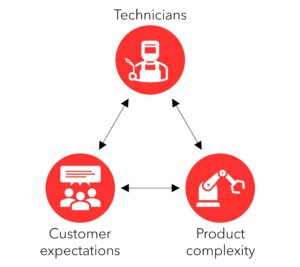Better customer service through digital information provision for service technicians
How can you make better use of scarce resources in customer service?
The shortage of skilled workers, increasingly complex products and demanding customers make the work of many industrial companies more difficult. This article explains how digital solutions can make life much easier for commissioning engineers or service technicians on site with customers.
Many companies that operate in the B2B sector and want to provide a good service to their customers face the following problem:

Customers have much higher expectations of service than in the past, good service technicians are hard to come by, and products are becoming more complex with new technologies. Accordingly, the demands on people in service are also increasing. Machines used to be completely mechanical, but nowadays they combine mechanics, electrics and software. Most companies have more than full order books for service technicians and commissioning engineers, but long queues on the customer side because they lack the human resources to process them appropriately.
To put the problem in numbers: In Germany alone, over the next 15 years, there will be a gap of 4-6 million workers retiring (Source in German). This gap will have to be filled by younger and thus often more inexperienced forces. In order to get an overview of the existing knowledge as quickly as possible, knowledge management tools such as internal company search engines can help to make the existing knowledge visible.
This is also the case for service engineers.
Service technicians and commissioning engineers have the task of putting company equipment into operation or repairing defective equipment. In doing so, they are frequently faced with the challenge of dealing with old models or newer but more complex machines. If the technician is on site, he must be able to rectify and solve problems as quickly as possible. To do this, he needs well-founded specialist knowledge, in a depth that can regularly only be achieved with years of experience.
However, in order to correctly interpret certain error (codes) and repair them accordingly, the technician requires appropriate access to best practices, guidelines, product data sheets, operating manuals and project information. However, these are usually stored in a very decentralized manner – they are located on network drives, the intranet, SharePoint or in other tools.
Finding the right information is then a task in itself – long clicks through folders, phone calls with office staff and other colleagues are not uncommon and ultimately cost the customer a lot of money. And if the service technician can’t find the right solution quickly enough, the company has to send out another technician the next day – making it even more expensive for the customer.
Not only is the customer then dissatisfied with the service he has probably been waiting for, but the contractor has also missed the opportunity to serve more customers, potentially putting a good reputation at risk in the medium term.
Index
How do service technicians get more knowledge?
To provide the right knowledge, today there are intelligent search solutions that analyze the existing knowledge across different data sources and make it available to the technician when he needs it. For example, it doesn’t matter to the technician whether he requires information about an old machine that may have come from scanned documents and is stored on the network or whether it is stored in various file formats such as explanatory images or videos. With a search engine, such information can be found without having to make phone calls to office staff or colleagues.
Advantages for technicians and companies
The technician can focus on his core task – repairing and commissioning machines. The more modern the solution, the greater the focus on the so-called user experience – in other words, easy and intuitive operability. This means that many of the tedious processes are automated, user interfaces are designed to be streamlined and modern, and where it makes sense, new, often AI-based technologies process the information better and faster. The company benefits in that technicians can work faster, and new employees are more quickly empowered to repair machines themselves with specific knowledge.
Preconditions for solutions
What conditions must be created to make such solutions usable for companies?
Two things are important here – the will and the courage of the decision-makers to initiate digitization in the service area as well, and then to bring the technician on board early on and involve him in the decision-making process. As with every successful introduction of a new tool, it is primarily about the employee and his processes and only secondarily about the solution. Technical solutions today are variable and adapt to different conditions to a certain extent. This can be used to optimize one’s own processes, make them more efficient, and thus (gain) an advantage over the competition.

Comments are closed.